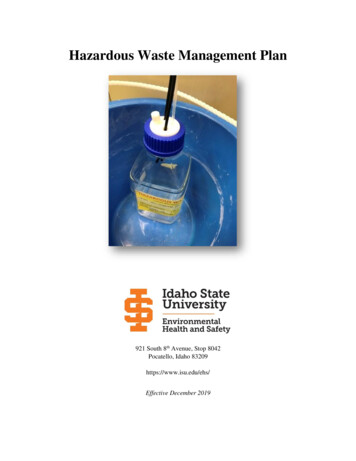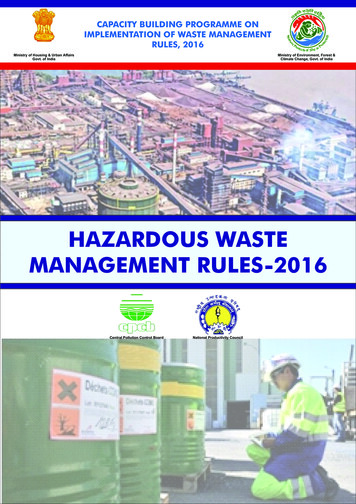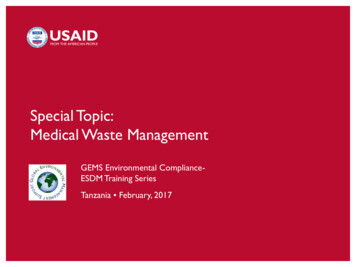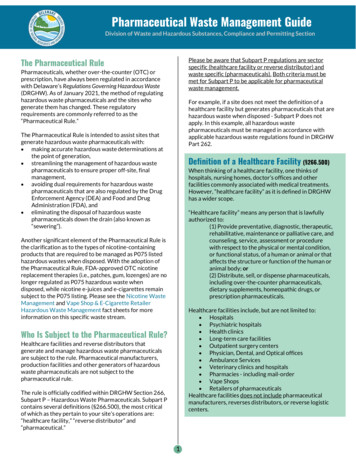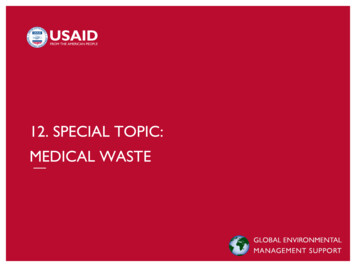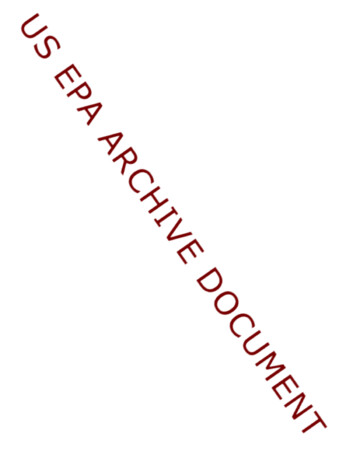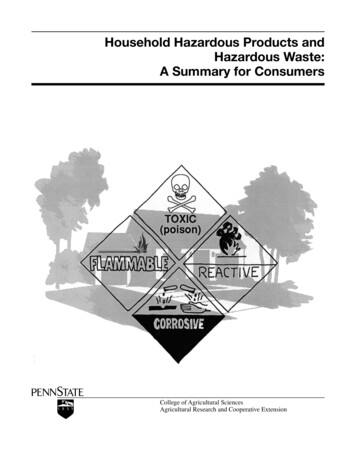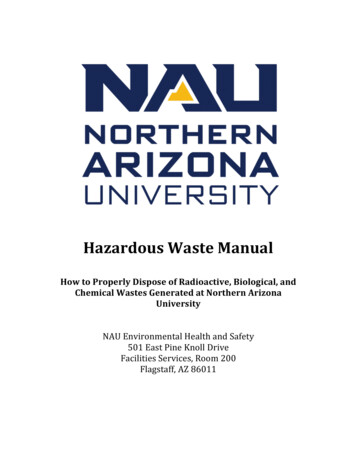
Transcription
Hazardous Waste ManualHow to Properly Dispose of Radioactive, Biological, andChemical Wastes Generated at Northern ArizonaUniversityNAU Environmental Health and Safety501 East Pine Knoll DriveFacilities Services, Room 200Flagstaff, AZ 86011
Table of ContentsIntroduction . 3Defining Biological, Radioactive, and Hazardous Waste . 4Classification of Hazardous Waste . 5Satellite Accumulation Area Requirements . 6Universal Waste (Batteries, Bulbs, etc.) . 7Non-Laboratory (Facilities) Generated Hazardous Wastes . 7Laboratory Generated Hazardous Wastes . 7Common Waste Types and Collection Requirements . 8Waste Pickup Requests . 10Combining Chemical Waste . 10DEA Scheduled Compounds . 10Unknown and/or Potentially Explosive/Toxic Chemicals . 11Appendix A . 12Appendix B . 13Appendix C . 14Appendix D . 152
IntroductionNorthern Arizona University initiated 5 Strategic Goals in 2019: Student Success andAccess; Research and Discovery; Commitment to Native Americans; Engagement;and Stewardship. Safety is specifically included in NAU’s Stewardship strategic goal.In support of this goal, as well as in support for academic success, research andothers, NAU generates biological, hazardous, and radioactive wastes. NAUEnvironmental Health and Safety is responsible for the training, storage, disposal,and transport of these wastes in accordance with federal, state, and localregulations.This document describes the origins, types, and procedures for waste disposal fromthe generator’s perspective. The requirements outlined below must be followed tocomply with state and federal regulations. A civil penalty under the ResourceConservation and Recovery Act (the EPA law regulating hazardous waste) iscurrently 72,718 per day per violation. For this reason, requirements set forth inthis document are a must or shall. Failure to adhere to these requirements mayresult in a fine and/or imprisonment to the University and/or parties involved.The handling of any biological, radiological, or hazardous waste on NAU campusrequires the user take training perspective to that area. Safe handling proceduresand training can be found on the EHS website at nau.edu/ehs. These trainingsinclude: NAU Chemical Hygiene Plan and TrainingNAU Radiation Safety Manual and TrainingNAU Biological Safety Manual and Biosafety TrainingNAU Hazard Communication Manual and Training3
Defining Biological, Radioactive, and Hazardous WasteBiological WasteBiological waste is material generated in laboratories, clinical sites, or other medicalwaste that contains, or potentially contains, biohazardous agents or recombinantDNA material. Biological waste generated at NAU includes:1. Cultures and stocks: Agents infectious to humans, animals, and plants, liveand attenuated vaccines and anything used to contain, mix or transferinfectious agents. This includes but is not limited to petri dishes, pipettes,pipette tips, microtiter plates, disposable loops, etc.2. Medical waste: generated in the diagnosis, treatment, or immunization ofhumans, either from clinical sites or research laboratories.3. Human blood, blood products and infectious body fluids: This categoryincludes blood that is not contained by a disposable item or is visiblydripping, serum, plasma, and other blood products or non-glass containersfilled with such discarded fluids. It further includes any substance whichcontains potentially infectious material as defined by the OHSA BloodbornePathogens Standard including:1. human body fluids: semen, vaginal secretions, cerebrospinal fluid,synovial fluid, pleural fluid, pericardial fluid, peritoneal fluid, amnioticfluid, saliva in dental procedures, any body fluid that is visiblycontaminated with blood, and body fluids in situations where it isdifficult to differentiate between body fluids,2. any unfixed tissue or organ (other than intact skin) from a human(living or dead) including cell or tissue cultures, and3. HIV or HBV-containing materials.4. Glass containers filled with such discarded fluids shall be consideredsharps.4. Sharps: needles, scalpel blades, hypodermic needles, syringes (with orwithout attached needles) and needles with attached tubing regardless ofcontact with infectious agents are medical waste. Other sharps includepasteur pipettes, disposable pipettes, razor blades, blood vials, test tubes,pipette tips, broken plastic culture dishes, glass culture dishes and othertypes of broken and unbroken glass waste (including microscope slides andcover slips) that may have been in contact with infectious material. Any itemthat can puncture or tear autoclave bags.5. Research animal waste including all carcasses and body parts andcontaminated bedding from animals that were intentionally exposed toinfectious agents during research.Radioactive WasteRadioactive waste may be either low-level or high-level waste. No high-level wastesexist on campus. Low-level waste includes all radioactive isotopes (including thosethat occur naturally) and/or discarded materials that are generated fromprocedures involving Bureau of Radiation Control licensing.4
Hazardous WasteThe Resource Conservation and Recovery Act defines hazardous waste. A used orunused chemical or combination of chemicals could be classified as a hazardouswaste by meeting one or more criteria, covered in detail below.Mixed WasteStaff, faculty, or students may create a waste that has a mixture of the abovehazards. Examples include but are not limited to: ICPMS waste with both an EPAregulated (RCRA) heavy metal and radioactive isotope (e.g. silver and uranium);animal remains previously exposed to arsenic; and many others. Mixed wastedisposal is expensive and challenging; prior to generating such wastes, contact EHSfor guidance.Classification of Hazardous WasteA hazardous waste may be defined as a “Listed Waste” and/or could meet thedefinition of a “Characteristic Waste”. Characteristic wastes meet one or morecriteria below:Hazardous waste Characteristics: Ignitability:o A liquid with a flash point 140 degrees Fahrenheito A solid that burns vigorously and/or persistently, either on its own orthrough absorption of moisture, or that undergoes spontaneouschemical change resulting in combustiono An oxidizero An ignitable compressed gasCorrosivityo An aqueous solution with a pH 2 or 12.5o A liquid capable of corroding steel greater than a quarter inch/year at130 degrees FahrenheitReactiveo Materials that are unstable or undergo violent chemical changewithout detonationo Materials that react violently with water, form potentially explosivemixtures with water, or release dangerous or lethal gases whenexposed to a pH between 2 and 12.5 that contain cyanide or sulfideo A DOT explosive, or material that is capable of detonationToxicityo Any solid or liquid waste that contains constituents equal to orgreater than the amounts specified in Appendix A5
Listed wastes on campus include discarded chemical products (DCPs) and wastesfrom non-specific sources. Non-specific source wastes are identified in Appendix B.The list of DCPs is too long to include in this document, but can be found at 40 CFR261.33 or by following this link: EPA Listed Wastes. Commonly found listed wastesare included in Appendix C.*Important note: certain chemicals do not meet the EPA’s definition of a hazardouswaste but are regulated by another entity. A common example is a reagent with a pHof 3; while the EPA doesn’t regard this as a corrosive RCRA waste, the City ofFlagstaff does not allow drain disposal of any chemical that has a pH outside therange of 6.5-9. Contact EHS for clarification on the drain or trash disposal of suchitems.Satellite Accumulation Area RequirementsNAU EHS supplies containers for biological, hazardous, and radioactive wastecollection. EHS prefers that laboratory personnel on campus re-use emptyreceptacles that previously contained reagents or products for small volume (lessthan 5 gallon) collection, as long as the container is in good condition, compatiblewith the contents, and is capable of being closed such that when it is on its side doesnot leak. Available container sizes and types for each waste are described below:Container Type4L Glass or Poly Bottle5-gal bucket or carboy (poly)15-gal drum open or closed head (poly)30-gal drum open or closed head (poly)55-gal drum open or closed head (poly)ChemicalXXXXXRadioactive BiologicalXXXXLiquid wastes shall only be collected in waste receptacles with a screw on lid orfastening top. Do not collect liquids in standard, construction style 5-gallon pailsEHS will refuse pickup, require users to transfer the waste, and/or bill departmentsfor disposal.Labeling and ManagementAll chemical hazardous waste receptacles at Satellite Accumulation Areas (SAAs) arerequired to have the following information conspicuously displayed:1. Contents2. Hazards of the contents (flammable, toxic, etc.)3. The words “Hazardous Waste”6
4. If the waste is a combination of chemicals, a log of the constituents shall beattached.a. Only bulk agreements where waste is a result of ongoing procedureswith identical substances and proportions may be collected without alog.The container must be closed at all times unless adding waste, compatible with thecontents therein, at or near the point of generation, and separated by a physicalbarrier from other wastes (or reagents) that are incompatible. Satellite wastecontainers are subject to preparedness, prevention, and emergency procedurerequirements. These are outlined in the EHS Hazardous Waste Contingency Plan,which can be found online at nau.edu/ehs.The maximum amount of waste that may be accumulated at a satellite site is 55gallons or 1 quart if the EPA designates the waste acutely hazardous. Once theselimits are reached or the container is full, the date must be marked on the containerand picked up by EHS within three calendar days for relocation to the HazardousWaste Facility.Universal Waste (Batteries, Bulbs, etc.)Universal wastes include batteries, fluorescent bulbs, mercury containingequipment, and certain pesticides. The Universal Waste Program is managed by theGeneral Maintenance Department. A drop off area is staged in the Facilities Building(#77) northernmost hallway. For questions concerning universal waste, pleasecontact Gabriel Gurrola (Gabriel.Gurrola@nau.edu).Non-Laboratory (Facilities) Generated Hazardous WastesDepartments outside of laboratories (such as the trades, residence life supportservices, dining, etc.) generate both universal and hazardous wastes. An importantnote: these areas tend to be the most scrutinized by inspectors. DepartmentSupervisors must ensure all chemicals are properly labeled, secured, stored, and arein useable condition (i.e. no expired products, dried up paint, etc.). In addition,supervisors are responsible for their department’s SAAs and as such, shall ensure allSAA requirements are fulfilled on a daily basis.Laboratory Generated Hazardous WastesAcademic and Research laboratories make up approximately 80 percent ofUniversity Generated Hazardous Waste. Laboratory supervisors (including bothPrincipal Investigators and Laboratory Managers) must ensure all chemicals are7
properly labeled, secured, stored, and are in useable condition (i.e. no expiredreagents, dusty containers, etc.). In addition, these personnel are responsible fortheir laboratory’s SAAs and as such, shall ensure all SAA requirements are fulfilledon a daily basis.Common Waste Types and Collection RequirementsPlease note: the details in the list below is recommended and, in some cases,mandatory. EHS understands if work or laboratory processes require collection insuch a way that these guidelines cannot be followed. However, they should befollowed when possible regardless of convenience, cost, or preference.Flammable and Non-Flammable Paints, Adhesives, Glues, etc.Do not mix flammable and non-flammable paint. Carpet adhesives, glues, caulking,varnishes, and other facilities related chemicals shall not be disposed of in the trashunless the SDS of the material or EHS specifically states that it is ok to do so.Formalin and FormaldehydeConcentrated, dilute, and/or virgin formalin/formaldehyde solutions must becollected and disposed properly by EHS.Ethidium Bromide Solutions and GelsConcentrated, dilute, and virgin ethidium bromide solutions and gels must becollected and disposed properly by EHS. PAGE gels shall also be collected, unlessEHS has approved trash disposal.Ignitable liquids and Organic SolventsSeparate halogenated and non-halogenated solvents. Keep aqueous wastes separatefrom organic solvents. Do not combine acidic/basic wastes with solvents or createbiphasic wastes when possible.Acids, Bases, and Aqueous solutionsKeep acids, bases, or aqueous solutions with RCRA heavy metals separate fromother wastes. Do not mix acids and bases. Do not collect, store, or transportcorrosives in metal containers.MercuryKeep mercury solutions and salts separate from other heavy metals. Do not use/buyelemental mercury unless it is imperative to research. If possible, please replace8
mercury thermometers and have them picked up by EHS ASAP by submitting anEHS Service request.Contaminated Solids/LiquidsKeep contaminated solids (gloves, pipettes, vials, paper towels, etc.) separate fromliquid wastes. Empty vials, test tubes, and other laboratory media with liquid priorto disposal.OxidizersKeep oxidizers (both dilute solutions, wastes, and virgin product) separate fromother wastes.Compressed GasesCompressed gas cylinders and lecture bottles shall be stored in an approved gascabinet and used in an area rated for their use if required. Inert gases shall complywith all OSHA and EHS requirements. For compressed gas container disposal, pleasetalk to your vendor about recycling prior to requesting an EHS pickup. If possible,use all the contents of the container such that it is in equilibrium with theatmosphere.Perchloric acid and PerchloratesPerchloric acid use requires a wash down hood. Keep perchloric acid andperchlorate wastes separate from all other wastes.Cyanides and Pseudo-cyanidesNever collect any cyanide wastes (including pseudo-cyanides such as potassiumhexacyanoferrate, guanidine thiocyanate, etc.) in a container larger than 1 liter. Donot combine cyanides with strong acids or oxidizers.Toxic WastesKeep toxic wastes (those displayed in Appendix A) and acutely hazardous wastes(from EPA Listed Wastes) separate from other wastes whenever possible.Explosive and Potentially Explosive MaterialsContact EHS immediately by phone if any expired peroxide forming (orcontaminated) solvents, dry picric acid, Tetrazole, and/or other explosive orpotentially explosive materials are found in the laboratory.9
Waste Pickup RequestsSubmit waste pickup requests prior to the point that containers will be overfull. Donot expect EHS to respond within a day; typical response time is 1-2 working daysfrom the date of submittal. See Appendix D for an example of how to fill out arequest.1.2.3.4.5.Gather waste containers designated for disposal.Place them in a common area such as a cabinet or lab bench (if possible)Go to nau.edu/ehs and click on “service request”Login using NAU credentialsFill out pertinent information using drop downs (note: do not attempt toenter your employee ID in the blank field at the top)6. In the comments section, detail the following information:a. Location of wasteb. Type of wastec. Number and size of containersd. Whether a replacement container or containers are needede. Ideal time for retrieval, if applicable7. If you wish to meet with EHS for pickup, please include one or two times amember of the team generating the waste is available in the ticket, along withtheir contact info unless the same person is submitting the request. EHS willthen contact the individual to setup a pickup appointment.Combining Chemical WasteContact EHS to combine wastes prior to doing so. The mixing of multiple chemicalwastes may result in a dangerous chemical reaction. Generation of toxic gases, heat,possible overflow or rupturing of receptacles, fire, and explosions are all possibleoutcomes when mixing hazardous wastes. The EPA’s waste compatibility chart(found here) may assist in determining whether or not two wastes can be mixedsafely. However, the chart is not to be used as the deciding factor in such scenarios.DEA Scheduled CompoundsAs required by law, only DEA Registrants can order, store, and distribute DEAScheduled materials. To become a DEA registrant, contact the NAU Office ofRegulatory Compliance.Upon discovery of a DEA Scheduled Material (common research compounds are inthe table below, a full list can be found here), NAU personnel shall contact NAU PDimmediately for disposal. If NAU PD cannot retrieve the material within the hour,contact EHS using a service request.10
AtropineBarbital/barticuric acidDiethyl PropionKetamineLorazepamBenzphetamineChloral HydrateDiazepamLaprozolamNitrazepamUnknown and/or Potentially Explosive/Toxic ChemicalsChemical wastes or reagents that are unknown pose a particularly dangerous threatdue to their unknown characteristics. NAU personnel shall not transport or handleany unknown chemical wastes without EHS approval. Upon discovery, submit aservice request immediately with a best guess or guesses as to the identification ofthe unknown chemical(s). If the potential for an unknown appears to beimmediately dangerous to life and health, contact NAU PD at 523-3000 or dial 911.Depending on the unknown’s properties, EHS reserves the right to charge theindividual, PI, department or departments responsible for disposal.Prevention of Unknown WastesNAU personnel shall prevent the production of unknown reagents and wastes.OSHA, GHS, and NAU Chemical Hygiene requirements set forth standards thatprevent the creation of unknowns. In summary, practice the following: Label all containers, regardless of size and contentsUse full names of chemicals, rather than abbreviationsUtilize a “chemical key” or legend for abbreviations when neededReallocate or waste the contents of “day-use” containersRe-label containers who have faulty or inadequate descriptionsAttach logs to chemical wastesInform fellow lab/department members what reagents/products your usingUpdate your chemical inventory at least once/yearPractice good housekeeping11
Appendix AToxicity Characteristic Compounds and 2,4,5 TP (Silvex)OrganicsBenzeneCarbon TetrachlorideChlorobenzeneChloroformCresol (otho, meta, and para)1,4-Dichlorobenzene1,2-Dichloroethane1,1 eHexachlorobutadieneHexachloroethaneMethyl ethyl 2,4,6-TrichlorophenolVinyl chlorideConcentration 53.0200.02.0100.05.00.70.5400.02.00.212
Appendix B13
Appendix CThis table contains commonly found Commercial Chemical Products that areregulated for disposal in a different manner than those previously mentioned.Unless a specific procedure or process requires these compounds to be wastedwith other reagents, please collect them separately for disposal.Be advised, this is only 18 of 200 plus chemicals that are listed.AldrinCyanide SaltsDieldrinEpinephrineNickel CarbonylOsmium TetroxidePropargyl AlcoholSodium azideVanadium PentoxideParathionHydrazinep-Benzoquinone *p-Nitrophenol *Phenol *Toluidine (ortho and para) * Trypan Blue *Benzo (a) pyrene*Acrylamide **These chemicals may be combined with other wastes, aslong as the concentration is provided in the servicerequest or on the label.14
Appendix D15
Defining Biological, Radioactive, and Hazardous Waste Biological Waste Biological waste is material generated in laboratories, clinical sites, or other medical waste that contains, or potentially contains, biohazardous agents or recombinant DNA material. Biological waste generated at NAU includes: 1.
